Johnston Hall remains on schedule to reopen by August 2014 following renovations, which began December 2012.
Once construction is completed, the hall will have spaces for 301 students along with common areas and study rooms.
“Most of these buildings were built for maximum capacity,” Department of Residential Life Director Frankie Minor said. “We have to create spaces that are accessible for all of our students.”
Johnston Hall renovations are part of the [master plan](http://reslife.missouri.edu/rlmp) developed by the Department of Residential Life.
“It takes us about a year and a half to renovate these (buildings),” Minor said. “Our job is to give students a variety of options of good spaces to live based on their needs.”
Students who lived in Johnston last year were required to move out by the end of the Fall 2012 semester.
One of the primary reasons for starting this project over winter break is that residential halls lose anywhere between eight and nine percent of their students after one semester, Minor said.
“We have done this seven times previously where we shut down halls in the middle of the semester,” Minor said.
MU officials decided to shut down Johnston for renovations well in advance of the closure.
Minor said the master plan for renovations across campus began 13 years ago when his department developed a long-term plan.
“We are trying to bring our facilities up to date. (Even though) it wasn’t in the worst condition, it was time,” said Chase Rother, residence hall coordinator at Johnston Hall before the renovations began.
These changes come as no surprise to at least one former resident.
“The rooms were really big compared to the other dorms, so I understand why they are remodeling,” junior Elena Plackis, who lived in Johnston two years ago, said. “The floor was really old.”
The residents who were forced to move as a result of the construction were given time to prepare and received help from the university when it came time to move their belongings to their new places of living. Minor explained that, in some cases, students had to choose which was more important: sticking with their current roommate or having the choice of which residence hall to transfer.
“(That was) quite an extensive process,” Rother said. “We try to get a sense of what is most important to each student.”
Nearly all of the staff members that were employed at Johnston have moved on.
Rother adjusted to a temporary support role within the department before taking charge of Mark Twain Hall across campus. New staff for Johnston will be hired at sometime in the next year.
Minor said Johnston will boast several new amenities that will improve the experience residents have there. There will be more common living space that further promotes the idea of community within the hall along with several options of places to study.
“With each renovation, we try to create more study places,” he said. “Johnston Hall will be the first residence hall on campus that will be LEED certified (with sustainable features). While we’ve been developing a lot of sustainable features in our prior renovations, the university had never pursued certification like that.”
LEED stands for Leadership in Energy and Environmental Design. Buildings that are efficiently run and built can earn this certification from the U.S. Green Building Council.
Sabai, a residential dining facility in the same building as Johnston, will now have its own entrance after the renovation because of the hassle the shared entrance proved to be. Minor said its renovation has been a separate project since the departments of Residential Life and Dining Services split into two entities more than two decades ago.
“The folks at Residential Life have the best plan for students to have a fantastic living experience,” said June DeWeese, a librarian at Ellis Library who lived in Johnston during her college years. “I made lifelong friends there.”








